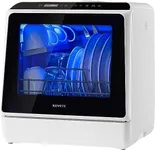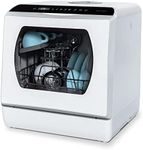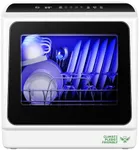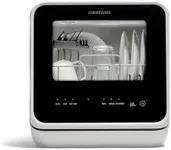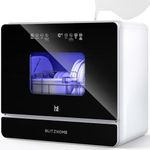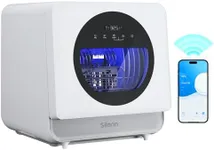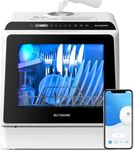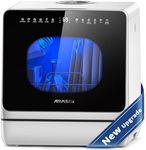Buying Guide for the Best Countertop Dishwashers
Choosing a countertop dishwasher can make kitchen life much easier, especially if you have limited space and want to avoid hand-washing all your dishes. These appliances are designed to sit on your countertop and connect easily to your kitchen tap, making them perfect for apartments, offices, or small kitchens. Before you buy, it's important to understand the key features and specifications so you can find a dishwasher that truly fits your daily needs and routine.CapacityCapacity refers to how many place settings a countertop dishwasher can handle in a single load. This is important because it dictates how many dishes, cups, or utensils you can wash at one time. Capacity is usually measured in place settings, and most countertop dishwashers can wash between 4 to 6 place settings per cycle. If you live alone or with just one other person, a smaller capacity should suffice, saving time and water. For small families or frequent entertainers, choosing a unit with a higher capacity means washing fewer loads. Think about your typical dishwashing load when assessing what capacity you need.
Size and DimensionsSize and dimensions tell you how much physical space the dishwasher will take up on your countertop and whether it'll fit under your cabinets. It matters because kitchens vary greatly in counter space and clearance. These appliances come in different shapes and sizes, so you'll see more compact versions and larger, chunkier ones. Before choosing, measure your available countertop space, especially the height under your cabinets, so you know if a model will fit. Match the size with your available space to ensure the dishwasher won't be an obstacle in your kitchen.
Water Source and InstallationThe water source—how the dishwasher gets its water—is key because it affects convenience and where you can use the appliance. Some countertop models connect directly to your kitchen faucet for easy setup, while others may have built-in water tanks you fill manually. Faucet-connection models work best if you can reserve your sink for the machine during a cycle, while tank models offer more flexibility but require regular refilling. Consider your kitchen setup and personal preference for maintenance when deciding which water supply method suits you best.
Cycle Types and DurationCycle types refer to the different washing programs offered, such as normal, eco, intensive, glass, rapid, or even baby care. Cycle duration is how long each program runs. This is important for customizing wash performance: more cycles give you control over cleanliness, water use, and speed. Some machines have quick washes, while others have longer, deeper cleans. Pick a dishwasher with cycles that match your typical habits—if you often wash lightly soiled dishes, quick and eco cycles are helpful; for greasy pots, an intensive cycle is better. If you need flexibility, look for models with more cycle choices.
Energy and Water UsageEnergy and water usage indicate how efficient the dishwasher is. Efficient models use less electricity and water, helping the environment and your utility bills. Usage is often listed in liters of water per cycle and sometimes in kilowatt-hours. Low water and energy numbers are better for eco-conscious buyers and those looking to save on running costs. Think about how often you'll use the machine: if you’ll run it daily, efficiency should be a top consideration.
Noise LevelNoise level tells you how loud the dishwasher will be when running, usually given in decibels (dB). This can be important if your kitchen is part of an open living space or if you like to run the appliance at night. Dishwashers with lower dB levels (below 50 dB) are considered quiet and won’t disturb daily life, while higher levels might be more noticeable. Consider your household’s noise sensitivity when deciding which model fits your lifestyle.
